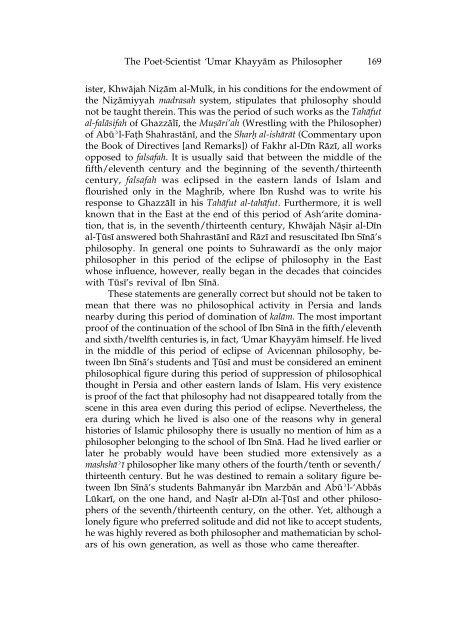Islamic Philosophy from Its Origin to the Present: Philosophy in the ...
Islamic Philosophy from Its Origin to the Present: Philosophy in the ...
Islamic Philosophy from Its Origin to the Present: Philosophy in the ...
You also want an ePaper? Increase the reach of your titles
YUMPU automatically turns print PDFs into web optimized ePapers that Google loves.
The Poet-Scientist ‘Umar Khayyåm as Philosopher 169<br />
ister, Khwåjah Niπåm al-Mulk, <strong>in</strong> his conditions for <strong>the</strong> endowment of<br />
<strong>the</strong> Niπåmiyyah madrasah system, stipulates that philosophy should<br />
not be taught <strong>the</strong>re<strong>in</strong>. This was <strong>the</strong> period of such works as <strong>the</strong> Tahåfut<br />
al-falåsifah of Ghazzål¥, <strong>the</strong> Mu„åri‘ah (Wrestl<strong>in</strong>g with <strong>the</strong> Philosopher)<br />
of Ab¨˘l-Fa†h Shahrastån¥, and <strong>the</strong> Shar÷ al-ishåråt (Commentary upon<br />
<strong>the</strong> Book of Directives [and Remarks]) of Fakhr al-D¥n Råz¥, all works<br />
opposed <strong>to</strong> falsafah. It is usually said that between <strong>the</strong> middle of <strong>the</strong><br />
fifth/eleventh century and <strong>the</strong> beg<strong>in</strong>n<strong>in</strong>g of <strong>the</strong> seventh/thirteenth<br />
century, falsafah was eclipsed <strong>in</strong> <strong>the</strong> eastern lands of Islam and<br />
flourished only <strong>in</strong> <strong>the</strong> Maghrib, where Ibn Rushd was <strong>to</strong> write his<br />
response <strong>to</strong> Ghazzål¥ <strong>in</strong> his Tahåfut al-tahåfut. Fur<strong>the</strong>rmore, it is well<br />
known that <strong>in</strong> <strong>the</strong> East at <strong>the</strong> end of this period of Ash‘arite dom<strong>in</strong>ation,<br />
that is, <strong>in</strong> <strong>the</strong> seventh/thirteenth century, Khwåjah Nå∑ir al-D¥n<br />
al-apple¨s¥ answered both Shahrastån¥ and Råz¥ and resuscitated Ibn S¥nå’s<br />
philosophy. In general one po<strong>in</strong>ts <strong>to</strong> Suhraward¥ as <strong>the</strong> only major<br />
philosopher <strong>in</strong> this period of <strong>the</strong> eclipse of philosophy <strong>in</strong> <strong>the</strong> East<br />
whose <strong>in</strong>fluence, however, really began <strong>in</strong> <strong>the</strong> decades that co<strong>in</strong>cides<br />
with T¨s¥’s revival of Ibn S¥nå.<br />
These statements are generally correct but should not be taken <strong>to</strong><br />
mean that <strong>the</strong>re was no philosophical activity <strong>in</strong> Persia and lands<br />
nearby dur<strong>in</strong>g this period of dom<strong>in</strong>ation of kalåm. The most important<br />
proof of <strong>the</strong> cont<strong>in</strong>uation of <strong>the</strong> school of Ibn S¥nå <strong>in</strong> <strong>the</strong> fifth/eleventh<br />
and sixth/twelfth centuries is, <strong>in</strong> fact, ‘Umar Khayyåm himself. He lived<br />
<strong>in</strong> <strong>the</strong> middle of this period of eclipse of Avicennan philosophy, between<br />
Ibn S¥nå’s students and apple¨s¥ and must be considered an em<strong>in</strong>ent<br />
philosophical figure dur<strong>in</strong>g this period of suppression of philosophical<br />
thought <strong>in</strong> Persia and o<strong>the</strong>r eastern lands of Islam. His very existence<br />
is proof of <strong>the</strong> fact that philosophy had not disappeared <strong>to</strong>tally <strong>from</strong> <strong>the</strong><br />
scene <strong>in</strong> this area even dur<strong>in</strong>g this period of eclipse. Never<strong>the</strong>less, <strong>the</strong><br />
era dur<strong>in</strong>g which he lived is also one of <strong>the</strong> reasons why <strong>in</strong> general<br />
his<strong>to</strong>ries of <strong>Islamic</strong> philosophy <strong>the</strong>re is usually no mention of him as a<br />
philosopher belong<strong>in</strong>g <strong>to</strong> <strong>the</strong> school of Ibn S¥nå. Had he lived earlier or<br />
later he probably would have been studied more extensively as a<br />
mashshå˘¥ philosopher like many o<strong>the</strong>rs of <strong>the</strong> fourth/tenth or seventh/<br />
thirteenth century. But he was dest<strong>in</strong>ed <strong>to</strong> rema<strong>in</strong> a solitary figure between<br />
Ibn S¥nå’s students Bahmanyår ibn Marzbån and Ab¨˘l-‘Abbås<br />
L¨kar¥, on <strong>the</strong> one hand, and Na∑¥r al-D¥n al-apple¨s¥ and o<strong>the</strong>r philosophers<br />
of <strong>the</strong> seventh/thirteenth century, on <strong>the</strong> o<strong>the</strong>r. Yet, although a<br />
lonely figure who preferred solitude and did not like <strong>to</strong> accept students,<br />
he was highly revered as both philosopher and ma<strong>the</strong>matician by scholars<br />
of his own generation, as well as those who came <strong>the</strong>reafter.

















